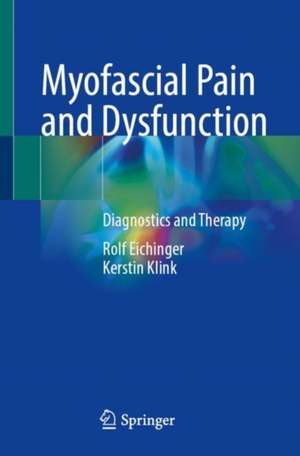Myofascial Pain and Dysfunction: Diagnostics and Therapy
Autor Rolf Eichinger, Kerstin Klinken Limba Engleză Paperback – 16 sep 2023
Fascia connects all parts of our body mechanically but more important, all our receptors for intro-and extroception and for the regulation of homeostasis are embedded in fascia. If you take this system into account in the differential diagnosis, you can spare your patients invasive, stressful diagnostics and offer an accurate and successful therapy.
Understand causes of fascial pain and dysfunction: fascial knots, principals of fascial disorders, flash tests, fascial chains, trigger points, interaction between cause and location of pain or other symptoms like fixed eczema and othersUnderstand causes of myofascial pain and dysfunction: myofascial knots, fascial chains, trigger points, interaction between cause and location of pain.- fascial slackness and blockages
- Clinic, symptoms
- Recognize fascial syndromes and pain patterns correctly
- Causal and permanently effective treatment approaches
- Therapy of the fascial system
- Causes of fascial disorders
- Cooperation doctor - physiotherapist
Preț: 485.91 lei
Preț vechi: 511.49 lei
-5% Nou
Puncte Express: 729
Preț estimativ în valută:
92.98€ • 96.07$ • 77.35£
92.98€ • 96.07$ • 77.35£
Carte disponibilă
Livrare economică 27 februarie-13 martie
Livrare express 12-18 februarie pentru 23.51 lei
Preluare comenzi: 021 569.72.76
Specificații
ISBN-13: 9783662680407
ISBN-10: 3662680408
Pagini: 101
Ilustrații: XIII, 101 p. 67 illus., 33 illus. in color.
Dimensiuni: 155 x 235 x 8 mm
Greutate: 0.2 kg
Ediția:1st ed. 2023
Editura: Springer Berlin, Heidelberg
Colecția Springer
Locul publicării:Berlin, Heidelberg, Germany
ISBN-10: 3662680408
Pagini: 101
Ilustrații: XIII, 101 p. 67 illus., 33 illus. in color.
Dimensiuni: 155 x 235 x 8 mm
Greutate: 0.2 kg
Ediția:1st ed. 2023
Editura: Springer Berlin, Heidelberg
Colecția Springer
Locul publicării:Berlin, Heidelberg, Germany
Cuprins
1. introduction.- 2. myofascial geloses or also blockages.- 3. pathophysiology.- 4. clinic of myofascial syndromes.- 5. general medical diagnosis and treatment approaches.- 6. therapy of the myofascial organ.- 7. case examples.- 8. the nodal model from the physiotherapeutic point of view - the KLINEA concept.- 9. assessment of findings in KLINEA.- 10. pathophysiological consideration from the physiotherapist's point of view.- 11. KLINEA assessment.- 12. KLINEA therapy.- 13. patient example.
Notă biografică
Rolf Eichinger, MD
Emergency, diving, nutritional medicine
General Medicine
91161 Hilpoltstein
Kerstin Klink
Physiotherapist 91154 Roth
Emergency, diving, nutritional medicine
General Medicine
91161 Hilpoltstein
Kerstin Klink
Physiotherapist 91154 Roth
Textul de pe ultima copertă
Patients often seek advice in the doctor's office whose complaints are of a functional nature and cannot be directly assigned to an organ disease via laboratory or imaging. Many of these disorders such as pain, dizziness, tinnitus, lumpiness or the "heel spur" originate from the fascial organ, which is only now slowly being understood as such.
The authors - a general practitioner and a physiotherapist - complement each other perfectly in their knowledge and skills. A plausible, practice-relevant, pathophysiological concept, which was created on the basis of many years of experience and success, as well as scientific studies (where available) and comes up with new - sometimes provocative - theses. For general practitioners, internists, orthopedists, physiotherapists and all physicians who are willing to enrich their diagnostic and therapeutic concepts with a myofascial approach.The translation was done with the help of artificial intelligence. A subsequent human revision was done primarily in terms of content.
Fascia connects all parts of our body mechanically but more important, all our receptors for intro-and extroception and for the regulation of homeostasis are embedded in fascia. If you take this system into account in the differential diagnosis, you can spare your patients invasive, stressful diagnostics and offer an accurate and successful therapy.
Understand causes of fascial pain and dysfunction: fascial knots, principals of fascial disorders, flash tests, fascial chains, trigger points, interaction between cause and location of pain or other symptoms like fixed eczema and othersUnderstand causes of myofascial pain and dysfunction: myofascial knots, fascial chains, trigger points, interaction between cause and location of pain.
- fascial slackness and blockages
- Clinic, symptoms
- Recognize fascial syndromes and pain patterns correctly
- Causal and permanently effective treatment approaches
- Therapy of the fascial system
- Causes of fascial disorders
- Cooperation doctor - physiotherapist
Caracteristici
Recognise myofascial syndromes accurately Understanding the causes of myofascial pain and dysfunction Clinic, diagnostics, complaint-specific treatment
